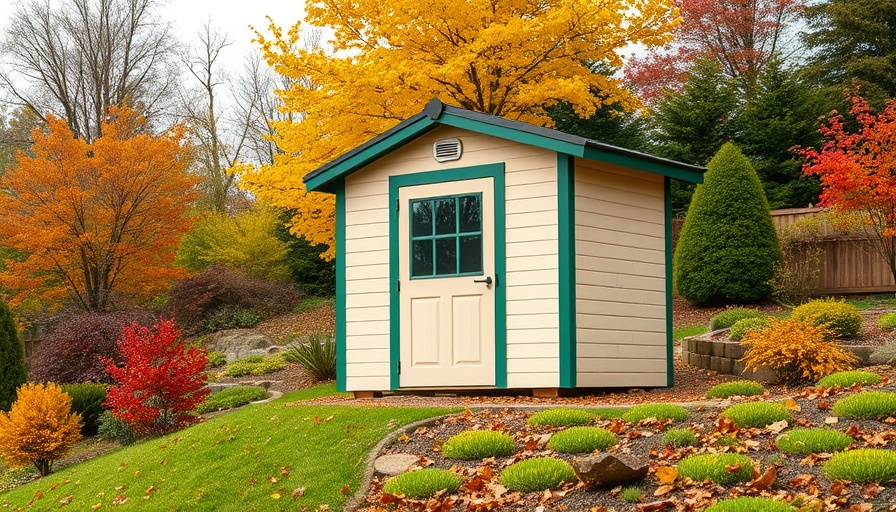
Transform Your Sloped Garden: Building a Stable Shed
Your garden terrain doesn’t need to be completely flat to construct a beautiful and functional shed. Instead of viewing slopes as obstacles, consider them as opportunities for innovative landscaping and design. In Connecticut's varying landscapes, how you build a shed on a slope can make all the difference. With well-thought-out planning and strategic construction, your shed can remain level and free from water disturbances.
Understanding the Slope: Measuring Like a Professional
The first step in your shed-building journey is to accurately map out the slope of your garden. Use simple materials like two stakes, twine, and a line level. By stretching the twine across the intended footprint and measuring the drop to the ground at the corners, you will know whether to opt for a stepped platform or a single, leveled base. Visualize this with sketches and use spray paint for marking high and low points, helping you stay oriented as you dig.
A valuable pro tip: observe the natural drainage patterns in your yard during rain. Good drainage is key to a stable shed. Consider how rainwater flows through your garden; directing it can prevent future issues with water damage.
Selecting the Right Foundation for Your Shed
Now that you've mapped the slope, it's crucial to choose the foundation strategy that best suits your landscape and preferences. Common methods include:
- Stepped Sleepers: Ideal for steeper drops, cut terraces with timber or masonry provide a tiered effect.
- Adjustable Pedestals: Great for quick installation and micro-adjustments under the frame of your shed.
- Ground Screws: Offer minimal digging while providing strong support for your structure.
- Modular Plastic Grids: Lightweight and easy to install, they are excellent for airflow and drainage.
Choose based on the slope's gradient, your budget, and how permanent you want your structure to be. If mobility is an option for you down the road, think about using modular systems.
Ensure Optimal Drainage Before Building
Water accumulation can be detrimental to your shed’s longevity. Therefore, setting up a drainage system before laying down the foundation is essential. Keep these key aspects in mind:
- Crown the Sub-base: Create a camber to ensure rainwater doesn’t settle.
- Gravel and Geotextile: Use gravel layers to enhance water drainage under the shed. A woven membrane will help prevent weeds.
- French Drain: If you are dealing with significant runoff, a gravel-filled trench can redirect water and protect your shed's base.
Extending gravel around the footprint of your shed by at least 100-150 mm will reduce splashback, further securing your shed from moisture damage.
Building Your Shed with Precise Sequences
Now, let's build your shed step by step for efficiency and effectiveness on a slope:
- Strip and Square: Remove unnecessary turf and square the footprint using the 3-4-5 rule.
- Compact the Sub-base: Proper compaction, whether with a hand tamper or a plate compactor, ensures stability.
- Step or Shim: Utilize your chosen base method to ensure the shed is level.
- Lay the Platform: Once your base is set, check for level on all sides.
- Anchor It: Secure the structure to the ground or to the sleepers to withstand wind and slight ground shifts.
Framing and flooring your shed can now occur with peace of mind, knowing that your foundation is strong and securely anchored against potential movement.
Your Shed on a Slope: A Success Story for Homeowners
Building a shed on a sloped garden doesn’t just fulfill a storage need—it enhances the aesthetic of your outdoor space, serving as a testament to smart, adaptive gardening. For homeowners in places like Fairfield County, Connecticut, incorporating a custom shed into the sloped terrain offers not only practical utility but also increases property value.
While it may seem daunting, overcoming the challenge of a slope can lead to innovative design solutions that uniquely benefit your garden. The satisfaction of turning a tricky slope into a stunning shed can inspire further projects in your yard, revitalizing your entire outdoor experience.
Ready to Get Started?
With this guide, you should feel empowered to tackle the challenge of building a shed on a slope. For more tips on improving your home's outdoor space, or if you have questions about lawn care and pet spaces in your garden, don’t hesitate to reach out to local professionals. Your backyard dreams are just a few plots away!
 Add Row
Add Row  Add
Add 




Write A Comment